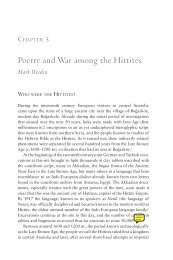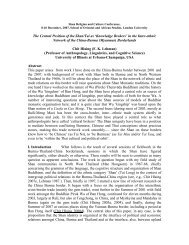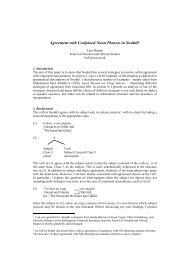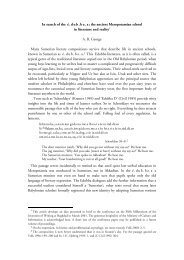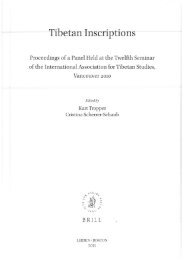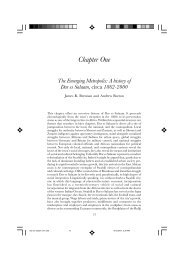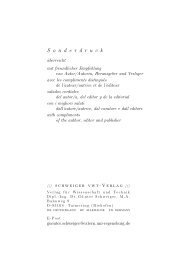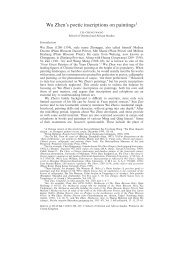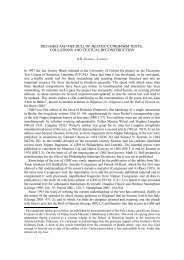Literarische Stoffe - The School of Oriental and African Studies
Literarische Stoffe - The School of Oriental and African Studies
Literarische Stoffe - The School of Oriental and African Studies
Create successful ePaper yourself
Turn your PDF publications into a flip-book with our unique Google optimized e-Paper software.
104<br />
Almut Hintze<br />
Accordingly, a v£šaptaþa-day is one that is inserted between periods <strong>of</strong> seven days. By analogy<br />
with the name <strong>of</strong> the month’s Ÿrst day, ahurahe mazdå <strong>and</strong> with that <strong>of</strong> the 15 th , full moon<br />
day, daþušÚ, the two v£šaptaþa- days 8 <strong>and</strong> 23 were also dedicated to the ‘Creator’, 13 so that<br />
three <strong>of</strong> the four periods started with the day daþušÚ. By insertion <strong>of</strong> a day 8, the original day<br />
15, dedicated to Mithra, became day 16, while the original day 14 <strong>of</strong> the ‘Creator’ (daþušÚ)<br />
became day 15 <strong>and</strong> thus replaced Mithra as the name <strong>of</strong> the Ÿrst day <strong>of</strong> the second half<br />
month. 14<br />
Bielmeier further suggests that two v£šaptaþa days were inserted during the seven summer<br />
months, thus yielding seven 30-day months, <strong>and</strong> one in the winter producing Ÿve 29-day<br />
months. Since every lunar year has Ÿve lunations <strong>of</strong> 29 <strong>and</strong> seven <strong>of</strong> 30 days, the months <strong>of</strong> 29<br />
<strong>and</strong> 30 days respectively were clearly identiŸable. As a result, the Zoroastrian 30-day month<br />
consists <strong>of</strong> two 7-day periods followed by two 8-day ones, as listed both in Y 16.3–6 <strong>and</strong> in<br />
Siroze 1 <strong>and</strong> 2, while a 29-day month consists <strong>of</strong> two 7-day periods followed by one 8-day <strong>and</strong><br />
one 7-day period. <strong>The</strong> v£šaptaþa- days were thus an indispensable means <strong>of</strong> keeping a skeleton<br />
month <strong>of</strong> four equal 7-day periods in agreement with a moon phase <strong>of</strong> 29 or 30 days.<br />
While twelve moon phases make up a lunar year <strong>of</strong> 354 to 355 days, the earth makes a<br />
complete rotation around the sun in 365¼ days. <strong>The</strong>refore, the solar year is longer than twelve<br />
lunations by between ten <strong>and</strong> twelve days, <strong>and</strong> a purely lunar year would soon be out <strong>of</strong> sync<br />
with the seasons. For this reason, those who reckoned the year by twelve lunar months had to<br />
adjust it to the seasons by adding extra days. Usually, as in the case <strong>of</strong> the Babylonian lunar<br />
calendar, this was done by inserting an extra month every few years. In this way the<br />
Babylonians ensured that their New Year on 1 Nisannu always fell in the early spring-time,<br />
while the beginning <strong>of</strong> every month roughly agreed with the new moon. 15 All calendars share<br />
two main features: a lunar element deŸning smaller, but not strictly equal time units, <strong>and</strong> a<br />
divides a period <strong>of</strong> 14 days into two halves <strong>of</strong> 7 days each at the moment <strong>of</strong> the waxing <strong>and</strong> waning half<br />
moons respectively.<br />
13 Bielmeier 1992, 54 fn. 93 accepts Kellens’ contention that Ahura Mazd¡ “n’est pas un dieu créateur” (in<br />
C.-H. de Fouchécourt & Ph. Gignoux (eds.), Études irano-aryennes <strong>of</strong>fertes à Gilbert Lazard. Paris 1989<br />
(Studia Iranica, cahier 7), 217–228), <strong>and</strong> therefore translates daþušÚ as “Ordner”. However, Kellens’<br />
arguments are not convincing, see Hintze 2007, 162–167.<br />
14 In Vedic astronomy a month is comprised <strong>of</strong> twenty-seven or twenty-eight stars or groups <strong>of</strong> stars (nakatra-),<br />
one <strong>of</strong> which is supposed to conjoin with the moon each night. <strong>The</strong>re are twenty-eight names <strong>of</strong> nakatra-,<br />
each being associated with a deity (see Pingree 1978, 535), <strong>and</strong> it is perhaps no coincidence but rather IIr.<br />
heritage that the Ÿfteenth is dedicated to Mitra.<br />
15 Bickerman 1983, 778f. According to him, by the time <strong>of</strong> the Persian conquest in 539 BC, the Babylonians<br />
were already aware that 235 months = 19 solar years, <strong>and</strong> from the beginning <strong>of</strong> the 5 th century had<br />
established a cycle <strong>of</strong> seven intercalations every nineteen years.



